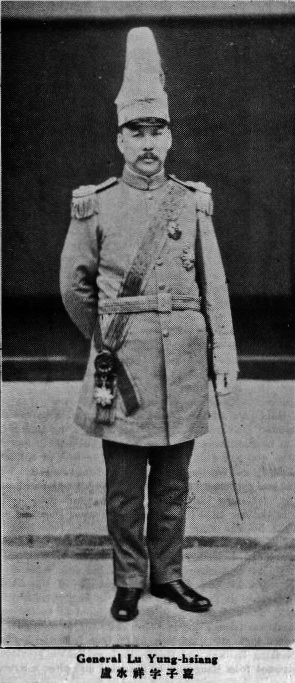Who's Who in China (3rd edition)/Lu Yung-hsiang

General Lu Yung-hsiang
盧永祥字子嘉
General Lu Yung-hsiang was born at Tsi-yang Hsien, Shantung Province, in 1867. He joined the Shanhaikuan Military Academy in 1887 and graduated from it in 1891. General Lu joined the army after graduation and worked his way up. On account of his bravery he soon became known as an able infantry commander in the Peiyang Army. From the rank of Tsung-ping or Brigade General to that of Ti-tu or Provincial Commander-in-Chief. Next promotion ranked him as Fu Tu-tung or Manchu General. General Lu held at different times the following positions under the Ching regime: Assistant Commander of the Right Wing of the Shantung Troops; Commander of several Regiments of left Division of the Peiyang Troops; Infantry Commander of the 11th Brigade of the Imperial Army; Commander-in-Chief of the 5th Brigade of the Imperial Army. In 1911 General Lu became Commander of the 5th Mixed Brigade with the rank of a Major-General. When the First Revolution broke out in October that year, his soldiers fought bravely on the side of Imperialists at Nang Tzu Kuan, the month of Shansi, on the Cheng Tai Railway. In 1912 President Yuan Shih-kai promoted General Lu to be a Lieutenant General and was soon appointed Commander of the 20th Division of the National Army. In 1914 General Lu was transferred to be Commander of the 10th Division. During that period he was conferred the Fourth Order of Merit and the Second Class Paokuang Chiaho Decoration. In December 1915 he was appointed Assistant Defence Commissioner of Shanghai and Woosung while General ang was the Principal Commissioner. In January 1917 General Yang became Tuchun of Chekiang and General Lu was promoted Defence Commissioner of Shanghai and Woosung still commanding the 10th Division. He was concurrently Co-Director of the Military Affairs of Kiangsu. In July 1917 General Chang Hsun effected a monarchical restoration and the new imperial government appointed General Lu the Military Commander-in-Chief of Kiangnan, south of the Yangtze. During 1918-19 General Lu's soldiers were totally engaged in the construction of the macadamized road from Shanghai to Woosung. In August 1919 he was appointed to be concurrently the Tuchun of Chekiang, to succeed General Yang Shan-te who had died at Hangchow. The post of Military Commissioner of Shanghai and Woosung was not relieved until July 1920 when General Ho Feng-lin was appointed to that post and he himself became the Tuchun of Chekiang. In March 1920 General Lu was awarded the First Order of Merit and in October 1920 the First Class Tashou Paokuang Chiaho. In January 1922 he was made a Full General. In June 1922 General Lu severed his connection with the Peking government by abolishing the Tuchun system and declaring himself the Director of Military Affairs of Chekiang. Up to September 1924, he was the only Anfu General who managed to retain his post following the collapse of the Anfu party in 1920. As a result of the Civil War which began in September 1924, Marshal Lu was finally defeated after what was considered to be the most serious. fighting which has taken place in China since the Revolution. The Chihli forces launched their attack on Marshal Lu both from the North along the Shanghai-Nanking Railway and the South from Fukien province. Marshal Lu first retreated from Hangchow to Shanghai and after a strong stand at Shanghai was forced to retire and go to Japan. Following the defeat of the Chihli party in the North Marshal Lu returned to China by way of Mukden where he received support from Marshal Chang Tso-lin and finally was appointed Tuchun of Kiangsu province with headquarters in Nanking, where he is now stationed.
